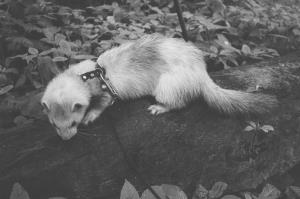Blue Ferret Syndrome
by Bill Beck
Trust Yogi to invent a new health problem for ferrets, or at least one that we had never heard of before.
We were walking Yogi and Boo Boo on the water meadows at the end of our road when we came upon the remains of a sycamore tree. This had been recently felled and the trunk cut up with a chain saw. The rest of the tree had been put through a shredder and there was a pile of chippings, about half a cubic metre or so, beside the path. Boo Boo ignored the pile and trotted on ahead with Ann but Yogi made a bee-line for the chippings and dived in.
 I let Yogi 'snow-plough' through the pile while I scanned around for dogs. When I looked back I was horrified to see smoke rising from the pile of chippings and no sign of Yogi. I quickly hauled him out by his lead and was shocked to find that his head had turned from its normal cream colour to a dark greyish-blue! He was also coughing and sneezing. Examination of the pile showed it to be warm but not hot. It certainly wasn't on fire but every time I disturbed it a cloud of 'smoke' rose up. It soon dawned on me that this was in fact a cloud of fungal spores and these were what was staining the fur on Yogi's head blue.
I let Yogi 'snow-plough' through the pile while I scanned around for dogs. When I looked back I was horrified to see smoke rising from the pile of chippings and no sign of Yogi. I quickly hauled him out by his lead and was shocked to find that his head had turned from its normal cream colour to a dark greyish-blue! He was also coughing and sneezing. Examination of the pile showed it to be warm but not hot. It certainly wasn't on fire but every time I disturbed it a cloud of 'smoke' rose up. It soon dawned on me that this was in fact a cloud of fungal spores and these were what was staining the fur on Yogi's head blue.
I was immediately concerned that Yogi might have inhaled lots of the spores and that this could give him a variety of 'farmers lung' or aspergillosis to give it its proper medical name. This ailment is seen in people who have handled hay or straw which has become damp and gone mouldy in storage. It is a disease of the lung caused by inhalation of the mould spores which subsequently germinate and grow over the surface of the lung causing breathlessness.
Over the next couple of days we kept a close eye on Yogi. He seemed to be unaffected at first but then we noticed that his breathing was becoming irregular and rather laboured. He was also sleeping more than usual and had stopped playing with Boo Boo. We took him to our vet straight away and explained the problem. The vet treated Yogi by putting him in a nebuliser unit actually designed for asthmatic babies and giving him 1ml of an anti-fungal drug, Fungazone 50. He repeated this treatment the next day. Yogi soon started to improve but it was about a fortnight before he was back to his normal self again.
Woodchips are a potential peril for any ferret who goes out and about either walking or working, or perhaps even in your own back garden. We believe that we were actually very unlucky and that given a day or two more the fungal activity in the chippings would have died down as they dried out. However, it is something for all ferret owners to bear in mind. We are just grateful that Yogi made a full recovery, and now we always check any chippings before we let 'our boys' go anywhere near them.
